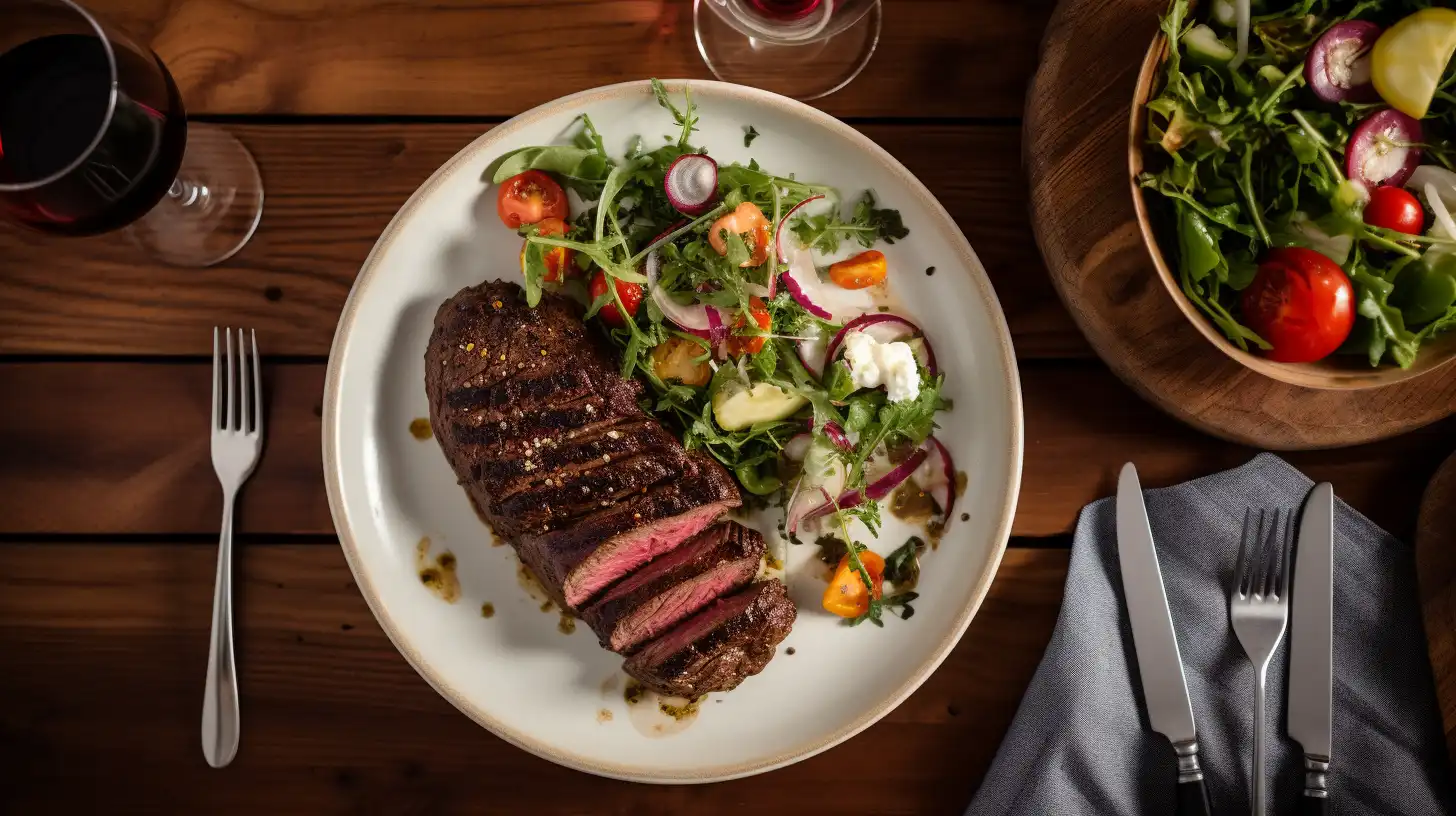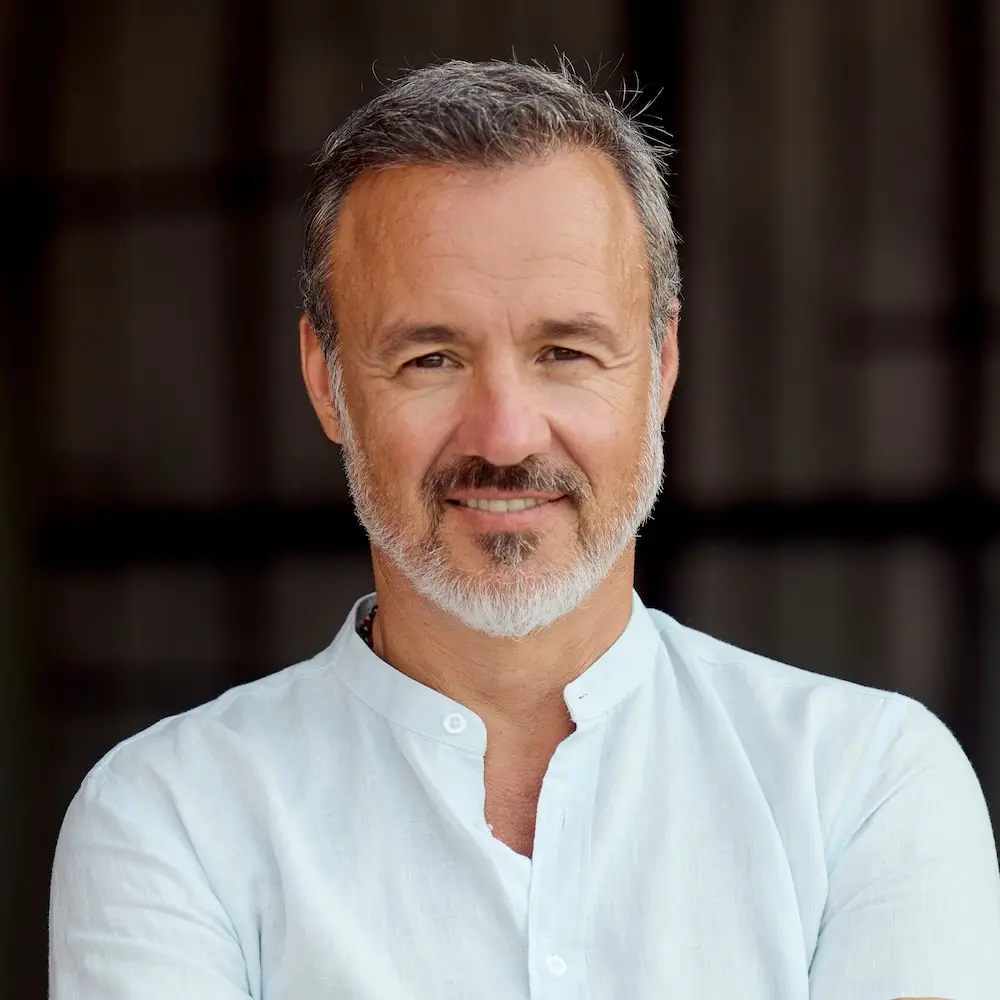Many of us grew up on TV dinners, snack packs, fast foods, fizzy drinks, canned and boxed everythings… Far from the ancestral diet of our hunter-gatherer great-great-great-forebears.
And little did we know how damaging it truly could be.
“Humans are supposed to be the smartest animals on the planet, and yet, we suffer with more illness and disease than any other animal on Earth,” says Eric Edmeades, the creator of WILDFIT®, in his Mindvalley program of the same name.
After a lifetime of shoveling in beige crap masquerading as food and suffering for it, we’re finally waking up. And this time, we’re feeding the future, not our cravings.
What is an ancestral diet?
The ancestral diet is an umbrella term for eating natural, unprocessed foods, like the kind people used to get by hunting, fishing, and gathering straight from the land and water.
Granted, we no longer have to actually hunt and gather for our food (unless tracking down hummus in a crowded store is your idea of ancestral survival). But the whole idea is to eat what’s natural, organic, and in sync with the four seasons of the human diet.
“It’s not just a set of rules but a way of reconnecting with foods our bodies evolved to process,” explains clinical dietician Marloes Mulder. “Unlike strict diets like paleo or carnivore, it’s flexible.” That means you can even eat foods that appeared after modern agricultural development, including dairy, grains, and healthy fats.
It sounds simple, sure. But in a world of processed everything, it’s a big shift. And a necessary one.
Your health is far more dependent on you getting enough of the good stuff than it is on you eliminating the bad stuff.
— Eric Edmeades, trainer of Mindvalley’s WILDFIT program
The ultra-processed foods we’ve been eating are linked to a rise in chronic diseases like obesity, type 2 diabetes, heart disease, and high blood pressure.
According to the CDC, nearly half of U.S. adults now have high blood pressure, while over 38 million Americans live with diabetes. The World Health Organization also names poor diet as a major driver behind the global surge in cardiovascular disease and obesity.
Let’s not kid ourselves. Our bodies were never built to run on processed snacks and sugar bombs. And getting back to real, whole foods might be the smartest thing we ever do.
Ancestral diet vs. other diets
Hear the word “diet,” and chances are, you picture counting calories, nibbling on a sad carrot, or swearing off bread for the third time this month.
Turns out, that’s not just in your head. Eric shares that a British newspaper reported that most people go on two diets a year, each one lasting an average of just six days. That’s 12 days a year spent trying to eat better… and 353 days falling right back into old habits.
But fueling the body the way our ancestors did is way different than the traditional diet that we’ve come to know (and, honestly, dread). Here’s a closer look at how it compares to two usual food fads your favorite Karen swears by.
Ancestral diet vs. paleo diet
| Feature | Ancestral diet | Paleo diet |
| Philosophy | Eat like your ancestors, but keep it flexible and seasonal | Eat like humans did before farming started |
| Food variety | Includes both plant and animal foods, even some modern ones | Excludes all grains, legumes, dairy, and processed foods |
| Modern food allowed | Allows some dairy, grains, and healthy fats if tolerated | No dairy, grains, or anything post-agriculture |
| Focus | Seasonal eating, local sourcing, and body awareness | Historical accuracy and ingredient restrictions |
| Approach | Fluid and adaptive | Rule-based and often strict |
Ancestral diet vs. carnivore diet
| Feature | Ancestral diet | Carnivore diet |
| Philosophy | Balanced eating inspired by ancient lifestyles | Eat only animal-based foods |
| Food variety | Plants and animals | Only meat, fish, eggs, and animal fats |
| Carbs | Encourages natural sources like fruits and root veggies | No carbs at all |
| Fiber | Supports gut health through fiber-rich foods | No fiber, since no plant foods are eaten |
| Approach | Adapts to your environment and biology | Extremely strict and exclusionary |
Ancestral diet benefits
“Your health is far more dependent on you getting enough of the good stuff than it is on you eliminating the bad stuff,” says Eric. And we know our ancestors didn’t have access to Pop-Tarts, Diet Coke, and whatever junk the food industry has stocked up in our local grocery stores.
Studies of foragers like the Tsimane of Bolivia, the Arctic Inuit, and the Tanzanian Hadza have found that these people traditionally didn’t develop high blood pressure, atherosclerosis, diabetes, or cardiovascular disease.
While the human body hasn’t changed much over the past 2.6 million years, the theory goes that our genes haven’t had enough time to adapt to farmed and processed foods. The truth is, we’ve only been eating them for the last 10,000 years.
So what did they get from their food that the rest of us so-called “civilized people” are missing out on today? Here’s what an ancestral diet gave them:
- Better energy levels
- Improved digestion
- Reduced chronic inflammation
- Weight management
- Stronger immune system
- Better blood sugar control
- Better heart health
- Mental clarity
- Fewer food cravings
- A stronger connection to food
Another big benefit? It’s great for your gut.
Marloes shares that eating this way means getting a variety of plant-based fibers, avoiding harmful additives, and including fermented foods, all of which help your gut microbiome stay strong and balanced.
“This approach,” she adds, “helps restore and maintain gut integrity and function in ways many modern diets can’t match.”
Ancestral diet food list: What to eat and what to avoid
If the ancestral diet is what our great-great-great-everythings ate for thousands of years, why do we struggle with it?
Marloes says it comes down to two things:
- Identity. You have to see yourself as someone who eats healthy, natural food, not just someone trying a new plan.
- System setup. Your environment needs to support your choices. That means stocking real food, planning ahead, and prepping so healthy eating is the easy option.
And part of that struggle, as functional medicine expert Chris Kresser explains in The Paleo Cure, comes from how far our culture has drifted from traditional wisdom.
“Your grandparents may have eaten these foods, but chances are you don’t,” he points out. “This has happened in large part because of the misguided campaigns against saturated fat, cholesterol, and red meat. But it’s also a consequence of our love for all things modern and our tendency to discount the knowledge of the past.”
So if we’re aiming for food freedom and eating the way our bodies were designed to, it helps to know what that really includes. And what it leaves out.

What to eat
So, what did our ancestors actually eat? That depends entirely on geography, climate, and culture. Many traditional ways of eating still reflect this today:
- Indian Jains have followed a vegetarian diet for generations.
- Malaysia’s Bajau people, who live almost entirely at sea, rely heavily on fish.
- The Arctic Inuit are known for their meat-based diet.
- In the “Blue Zones” of the Mediterranean and Japan, people still eat mostly plants, oily fish, fermented foods, and natural fats.
- Some cultures have eaten grains for over 100,000 years, while others have a lower tolerance.
The point is, what makes an ancestral diet isn’t what’s in it but rather where it’s from. And if you want to explore ancestral eating for yourself, here’s a simple place to start:
1. Fresh vegetables
While the types and amounts of vegetables would differ from era to era and place to place, and a large portion of calories came from meat, vegetables still should take up ample space on the ancestral diet plate.
Think:
- Leafy greens: spinach, kale, collard greens, Swiss chard
- Cruciferous veggies: broccoli, cauliflower, cabbage, Brussels sprouts
- Root vegetables: carrots, beets, parsnips, turnips
- Other seasonal staples: zucchini, cucumbers, eggplant, bell peppers, green beans
They’re all rich in fiber, antioxidants, and essential nutrients that support everything from digestion to immune health.
“The core goal is to get a wide variety of high-quality vegetables into your life,” Eric advises. So when possible, go for organic and seasonal produce. It’s closer to how nature intended.
2. Seasonal fruits
“Fruits and veggies don’t fight disease,” says Eric. “Their absence causes it.”
Fruits indeed offer natural sweetness that still needs balancing, but they also come with vitamins, minerals, and phytonutrients. In ancestral diets, fruit was eaten in season, not year-round. For instance, berries in summer, apples in autumn, or mangoes and guavas during tropical harvests.
This gave the body natural periods of higher and lower sugar intake, supported gut diversity through variety, and aligned with the environment’s natural cycles. Today, constant access to fruit (and fruit-like products) can overload the body with sugar and disrupt metabolic balance.
So stick to whatever grows naturally in your region and season, be it mangoes, bananas, papayas, citrus fruits, guavas, pineapples, apples, or berries. Just avoid the dried, juiced, or syrup-soaked versions that throw your blood sugar levels off balance.
3. Quality animal protein
One of the main ancestral diet foods comes from protein. This vital macronutrient serves as the primary building block for tissue growth, cell renewal, and repair throughout the body.
The thing is, as Chris notes in his book, “We may be well fed, but we’re undernourished.” His solution is to return to eating the way our ancestors did, “from nose to tail.”
“This means eating not only the lean muscle meat (like steak or chicken breast) of animals,” he suggests, “but also the organs, skin, cartilage, bones, and fattier cuts.”
But meats aren’t the only source of protein. You can opt for wild-caught fish, free-range poultry, and eggs as well. If you’re on #teamvegan, you have your choice of soy-based foods, whole grains, nuts and seeds, and legumes (just make sure you’re consuming the adequate amount, as plants have a lower protein digestibility compared to animal protein sources).
4. Healthy fats
According to Marloes, one myth that really needs to go is the idea that “fats are bad.” It’s an outdated, calorie-obsessed mindset that ignores what fats actually do for your body.
“In truth, quality fats—from grass-fed sources, avocados, and nuts—are essential for hormone production, brain function, and overall cellular health,” she explains. Writing off fat completely misses the point of how essential it is.
The key is using fats that come from real food, not factories.
5. Fermented foods
Long before refrigeration, fermentation was used to preserve food, but it also created natural probiotics that support gut health. Today, fermented foods for gut health are making a comeback, thanks to their role in feeding beneficial bacteria and improving digestion.
“In the process of fermentation, the microbes begin to break down the food, making it easier to digest and producing beneficial metabolites like short-chain fatty acids, vitamins, and antioxidants,” explains Hilary Keiser to Pulse.
The biochemist from Viome, a health tech company that focuses on gut health and personalized nutrition, adds that fermentation can help reduce compounds in certain foods that might be hard to digest, like glucosinolates and oxalates. Plus, the microbes involved act as probiotics and support a more diverse gut microbiome.
Hilary highlights that studies have shown eating multiple servings of low-sugar fermented foods per day can even reduce inflammation in the gut.
It’s a small habit, for sure. But it has the power to quietly reshape your health from the inside out.
What to avoid
Now, there are foods that fuel your body… and then there are the ones that quietly mess with your gut, energy, and hormones without you even realizing it.
Eating food that’s devoid of nutrients, like processed food, does not feed the microbiome. So it’s really important to focus on a whole food diet.
— Hilary Keiser, biochemist from Viome
These sneaky saboteurs might be everyday staples in your pantry or go-to comfort fixes, but they weren’t built for the human body.
Here are five of the biggest troublemakers worth rethinking:
1. Ultra-processed foods and artificial additives
Our ancestors didn’t eat food made in factories, and our bodies aren’t designed to process it either.
“Eating food that’s devoid of nutrients, like processed food, does not feed the microbiome,” Hilary points out. That’s all those Ramens, Chef Boyardees, McDonald’s… And while they may taste delicious, they don’t do your health any favors.
They’re often stripped of nutrients and packed with additives that can mess with your gut, throw off your blood sugar, and stir up inflammation. That’s why, as Hilary says, “it’s really important to focus on a whole food diet.”
2. Refined sugar and grains
Remember those breakfast cereals that totally made our childhood? They came in bright boxes, rainbow marshmallows, and a certain tiger who swore they were “grrreat.”
They promised energy, yes. Fun, absolutely. A balanced breakfast, ehhh, perhaps. But mostly, they delivered a sugar crash by 10 a.m.
That’s what refined sugar and grains do: they digest rapidly, causing blood sugar levels to rapidly rise followed by crashes. It can lead to energy dips, cravings, and long-term metabolic issues.
Not only that, but sugar’s going to raise serotonin and dopamine, as Eric points out. “It’s going to reward you for eating the food,” he says. But it’s not reeeally doing that. Rather, it’s “actually rewarding you for the emotional state.”
And it’s not only sugary cereals. Sodas, candies, chocolates, flavored yogurts, pasta, and baked goods made with refined white flour are up on that list as well.
So yeah, it tastes like comfort, but it’s wiring your brain to chase chaos.
Watch how the food industry is getting you addicted to sugar:
3. Industrial seed oils
You know these oils well. They’re stocked on the shelves with the names of canola, soybean, corn, sunflower, and generic “vegetable oils”… While they might seem harmless, they’re highly processed (extracted using high heat and chemical solvents) and often oxidized by the time they hit your plate.
They’re also high in omega-6 fatty acids, which, in excess, can throw off your body’s inflammatory balance. These oils hide out in processed snacks, salad dressings, sauces, and almost everything on a fast-food menu.
“If everyone on a standard American diet stopped eating cereal grains, industrial seed oils, and excess sugar tomorrow,” Chris notes in The Paleo Cure, “I’m willing to bet that the rates of obesity, diabetes, heart disease, and just about every chronic inflammatory disease would plummet over the next decade.”
4. Highly processed dairy
Well, it depends on what kind of dairy you mean. Traditional forms like raw milk or fermented yogurt were once nutrient-rich and full of beneficial bacteria. But the kind lining most grocery store shelves? They’re often ultra-pasteurized, low-fat, sweetened, and packed with gums and additives to keep them shelf-stable and palatable.
The problem goes beyond processing to how your body reacts to it. For Eric, he suffered from acne, sinus infections, stomach cramps, and spent years looking for answers.
Nothing worked. Until someone suggested cutting dairy. Within 30 days, his skin cleared, the pain vanished, and his energy came back. When he tried to reintroduce it, all the symptoms came flooding back.
We all know how it’s often praised as the go-to source of calcium, but research paints a different picture. Countries with the highest dairy intake, it seems, tend to have the highest rates of osteoporosis.
Turns out, milk might raise acidity in the body, which apparently can leach calcium from your bones instead of strengthening them (totally the opposite of what those “Got Milk?” ads promised). It’s also linked to inflammation, sinus congestion, and even hormonal imbalances because of the natural growth hormones meant for baby cows… not adult humans.
So if your body’s acting up, dairy might not be the comfort food you think it is.
5. Excess alcohol
There’s wine o’clock after work. Champagne to celebrate. A cold beer waiting in the fridge. Margaritas with tacos. A mimosa because it’s Sunday.
Alcohol is everywhere. It’s how we unwind, how we connect, how we say “cheers” to life.
But the question is, is alcohol bad for you?
Well, your body sure thinks so. In its purest form, alcohol triggers an immediate “no thanks” from your senses. The smell, the taste—it’s not exactly inviting without the sugar, flavors, and marketing spin.
Eric points out that no part of your biology is actually asking for alcohol. “It is only our psyche, our egos, and our emotions that want us to have it,” he says.
Physiologically, alcohol disrupts your gut microbiome, spikes blood sugar, and interferes with digestion (especially if you drink during meals, when your stomach acid should be focused on breaking down food, not battling your cocktail).
Not only that, but alcohol can hijack your brain’s ability to adapt. One study found that chronic drinking disrupts cholinergic interneurons (key brain cells for learning and behavior change), making it harder to unlearn habits that no longer serve you.
So yes, alcohol can be fun. It can mark a moment. But if you’re using it to feel more like yourself, it’s worth asking: what is it keeping you from already being yourself in the first place?
Bonus: Ancestral diet meal plan
If you’ve been stuck in the loop of skipping breakfast, snacking through lunch, and crashing by 3 p.m., your food might be the reason. That’s the thing, though: your biology doesn’t crave convenience; it craves real nourishment.
There are tons of ancestral diet recipes you can look up. But this sample plan gives you a clear way to start, using real food and simple structure to support your energy, digestion, and mood.
Morning:
- Warm lemon water or herbal tea to wake up digestion
- Scrambled eggs cooked in ghee with sautéed spinach, onions, and mushrooms
- A side of avocado or fermented veggies like sauerkraut
Mid-morning snack (if needed):
- A handful of raw nuts or a boiled egg
- Bone broth or a green juice (low-sugar, leafy greens, ginger, lemon)
Lunch:
- Grilled wild-caught salmon or pasture-raised chicken
- A big mixed salad with olive oil, lemon, and sea salt
- Roasted sweet potatoes or steamed broccoli
Afternoon pick-me-up:
- Herbal tea (like rooibos, peppermint, or dandelion root)
- A couple of dates or a few slices of cucumber with hummus
Dinner:
- Grass-fed beef stew or coconut curry with seasonal veggies
- Cauliflower mash or zucchini noodles on the side
- A few berries with coconut cream for dessert (optional)
Before bed:
- Chamomile or reishi tea to wind down
- Magnesium supplement or a warm bath with Epsom salts
This plan is just a starting point. The most nourishing meals are the ones that use what’s fresh, local, and in season where you live. Trust your roots, your region, and your body to guide you.
Live vibrantly, naturally
You’ve cleaned up your diet. You’ve tried eating “better.” But your body still feels off, held back by the cravings, the fatigue, the slow-creeping weight that doesn’t budge.
Eric Edmeades gets it. And in this free WILDFIT webinar, he shows you what no diet book ever told you:
- Why your cravings happen,
- What they’re really saying, and
- Why most weight-loss advice keeps failing people who are doing everything “right.”
There are hundreds of success stories of WILDFITers. Pushpa Nair, for one, said she was never into diets and struggled for years to find something that actually made sense.
That is, until she stumbled onto WILDFIT and lost 23kg, cleared her migraines, and gained more energy than she’d had in decades. She shares:
I feel at least 20 years younger. I am 53 years old and have never been in better health or shape—that’s something not many people can say.
Stories like hers didn’t start with big decisions. They started with one small “yes,” like showing up for a free webinar.
It’s just 32 minutes. That’s the length of time most people spend sitting in traffic. Or binging TikTok. Or watching an episode of Ted Lasso.
So if your body’s been waving red flags, maybe it’s time to stop ignoring them.
Take WILDFIT. See what shifts.
Welcome in.











